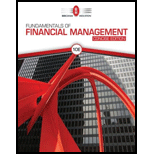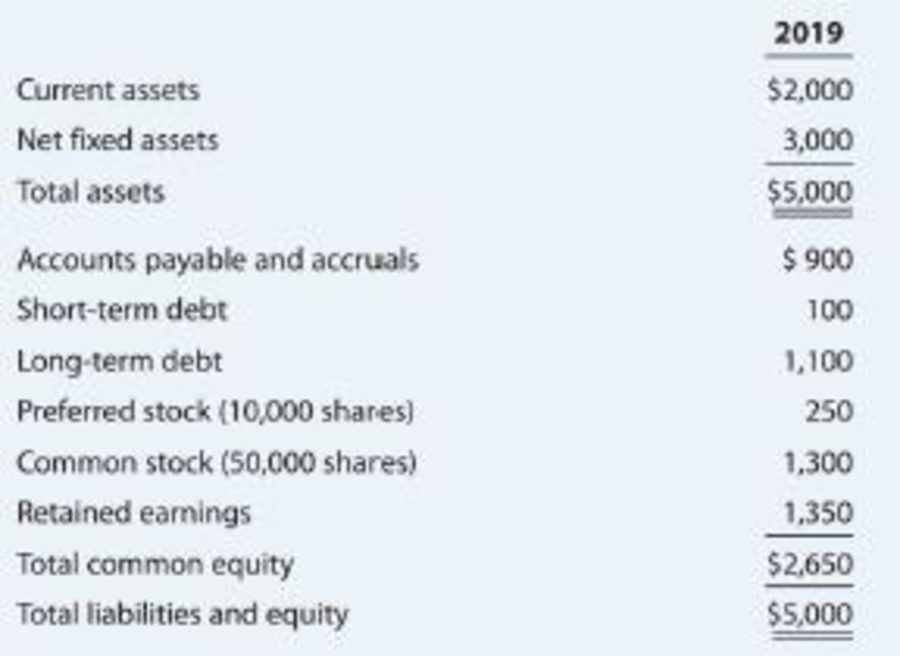
Concept explainers
CALCULATING THE WACC Here is the condensed 2019 balance sheet for Skye Computer Company (in thousands of dollars):

Skye’s earnings per share last year were $3.20. The common stock sells for $55.00. last year’s dividend (D0) was $2.10, and a flotation cost of 10% would be required to sell new common stock. Security analysts are projecting that the common dividend will grow at an annual rate of 9%. Skye’s
- a. Calculate the cost of each capital component, that is, the after-tax cost of debt, the cost of preferred stock, the
cost of equity fromretained earnings , and the cost of newly issued common stock. Use the DCF method to find the cost of common equity. - b. Now calculate the cost of common equity from retained earnings, using the
CAPM method. - c. What is the cost of new common stock based on the CAPM? (Hint: Find the difference between r1 and rs as determined by the DCF method, and add that differential to the CAPM value for rs.)
- d. If Skye continues to use the same market-value capital structure, what is the firm’s WACC assuming that (1) it uses only retained earnings for equity and (2) if it expands so rapidly that it must issue new common stock?
a.
To Determine: The after-tax cost of debt, cost of preferred stock, cost of common equity from retained earnings and cost of common equity from new common stock of Company SC.
Introduction: WACC is abbreviated as weighted average cost of capital, is a equation that computes the average rate of return that an organization requires to acquire to repay its security holders or investors. This computation is utilized to determine if a project is beneficial or in the event that it just repays the expense of subsidizing the project.
Answer to Problem 21SP
The after-tax cost of debt is 7.50%, cost of preferred stock is 11%, cost of common equity from retained earnings is 13.16% and cost of common equity from new common stock is 13.62%.
Explanation of Solution
Determine the after-tax cost of debt
Therefore the after-tax cost of debt is 7.50%.
Determine the cost of preferred stock
Therefore the cost of preferred stock is 11%.
Determine the cost of common equity from retained earnings
Here,
D0 - Current dividend
g - Growth rate
P0 - Current price of bond
Therefore the cost of common equity from retained earnings is 13.16%.
Determine the cost of common equity from new common stock based on DCF
Here,
D0 - Current dividend
g - Growth rate
P0 - Current price of bond
F - Flotation cost
Therefore the cost of common equity from new common stock based on DCF is 13.62%.
b.
To Determine: The cost of common equity from retained earnings of Company SC utilising CAPM method.
Answer to Problem 21SP
The cost of common equity from retained earnings of Company SC utilising CAPM method is 13.58%.
Explanation of Solution
Determine the cost of common equity from retained earnings using CAPM
Here,
rF - Risk free rate
rM - Market risk premium
B - Beta of stock
Therefore the cost of common equity from retained earnings using CAPM is 13.58%.
c.
To Determine: The cost of new common equity based on CAPM.
Answer to Problem 21SP
The cost of new common equity based on CAPM is 14.04%.
Explanation of Solution
Determine the difference between the cost of common equity from retained earnings and cost of common equity from new common stock
Therefore the difference between the cost of common equity from retained earnings and cost of common equity from new common stock is 0.46%
Determine the cost of new common equity based on CAPM
Therefore the cost of new common equity based on CAPM is 14.04%.
d.
To Determine: The WACC if the firm utilises only retained earnings for equity and if the firm expands rapidly in order to issue new common stock.
Answer to Problem 21SP
The WACC if the firm uses only retained earnings for equity and if the firm expands rapidly in order to issue new common stock
Explanation of Solution
Determine the market value of preferred stock
Therefore the market value of preferred stock is $300
Determine the market value of debt
Therefore the market value of debt is $1,200
Determine the market value of common stock
Therefore the market value of common stock is $2,750
Determine the total market value
Therefore the total market value is $4,250
Determine the weight of preferred stock
Therefore the weight of preferred stock is 7.06%
Determine the weight of debt
Therefore the weight of debt is 28.24%
Determine the weight of common stock
Therefore the weight of common stock is 64.71%
Determine the WACC if the firm uses only retained earnings for equity
For the rate of common stock, the average of old and new common stock values are considered.
Here,
wd - Weight of debt
rd - Rate of debt
T - Tax rate
wp - Weight of preferred stock
rp - Rate of preferred stock
we - Weight of common stock
re - Rate of common stock
Therefore the WACC if the firm uses only retained earnings for equity is 11.55%.
Determine the WACC if the firm expands rapidly in order to issue new common stock.
For the rate of common stock, the average of cost of new common equity based on CAPM and the cost of new common equity based on DCF values are considered.
Therefore the WACC if the firm expands rapidly in order to issue new common stock is 11.84%.
Want to see more full solutions like this?
Chapter 10 Solutions
Fundamentals Of Financial Management, Concise Edition (mindtap Course List)
- DIVIDENDS Brooks Sporting Inc. is prepared to report the following 2019 income statement (shown in thousands of dollars). Prior to reporting this income statement, the company wants to determine its annual dividend. The company has 320,000 shares of common stock outstanding, and its stock trades at 37 per share. a. The company had a 25% dividend payout ratio in 2018. If Brooks wants to maintain this payout ratio in 2019, what will be its per-share dividend in 2019? b. If the company maintains this 25% payout ratio, what will be the current dividend yield on the companys stock? c. The company reported net income of 1.35 million in 2018. Assume that the number of shares outstanding has remained constant. What was the companys per-share dividend in 2018? d. As an alternative to maintaining the same dividend payout ratio. Brooks is considering maintaining the same per-share dividend in 2019 that it paid in 2018. If it chooses this policy, what will be the companys dividend payout ratio in 2019? e. Assume that the company is interested in dramatically expanding its operations and that this expansion will require significant amounts of capital. The company would like to avoid transactions costs involved in issuing new equity. Given this scenario, would it make more sense for the company to maintain a constant dividend payout ratio or to maintain the same per-share dividend? Explain.arrow_forwardSmiley Corporations current sales and partial balance sheet are shown here. Sales are expected to grow by 10% next year. Assuming no change in operations from this year to next year, what are the projected spontaneous liabilities?arrow_forwardALTERNATIVE DIVIDEND POLICIES In 2018, Keenan Company paid dividends totaling 3,600,000 on net income of 10.8 million. Note that 2018 was a normal year and that for the past 10 years, earnings have grown at a constant rate of 10%. However, in 2019, earnings are expected to jump to 14.4 million and the firm expects to have profitable investment opportunities of 8.4 million. It is predicted that Keenan will not be able to maintain the 2019 level of earnings growth because the high 2019 earnings level is attributable to an exceptionally profitable new product line introduced that year. After 2019, the company will return to its previous 10% growth rate. Keenans target capital structure is 40% debt and 60% equity. a. Calculate Keenans total dividends for 2019 assuming that it follows each of the following policies: 1. Its 2019 dividend payment is set to force dividends to grow at the long-run growth rate in earnings. 2. It continues the 2018 dividend payout ratio. 3. It uses a pure residual dividend policy (40% of the 8.4 million investment is financed with debt and 60% with common equity). 4. It employs a regular-dividend-plus-extras policy, with the regular dividend being based on the long-run growth rate and the extra dividend being set according to the residual dividend policy. b. Which of the preceding policies would you recommend? Restrict your choices to the ones listed but justify your answer. c. Assume that investors expect Keenan to pay total dividends of 9,000,000 in 2019 and to have the dividend grow at 10% after 2019. The stocks total market value is 180 million. What is the companys cost of equity? d. What is Keenans long-run average return on equity? [Hint: g = Retention rate ROE = (1.0 Payout rate)(ROE)] e. Does a 2019 dividend of 9,000,000 seem reasonable in view of your answers to parts c and d? If not, should the dividend be higher or lower? Explain your answer.arrow_forward
 Fundamentals Of Financial Management, Concise Edi...FinanceISBN:9781337902571Author:Eugene F. Brigham, Joel F. HoustonPublisher:Cengage Learning
Fundamentals Of Financial Management, Concise Edi...FinanceISBN:9781337902571Author:Eugene F. Brigham, Joel F. HoustonPublisher:Cengage Learning EBK CONTEMPORARY FINANCIAL MANAGEMENTFinanceISBN:9781337514835Author:MOYERPublisher:CENGAGE LEARNING - CONSIGNMENT
EBK CONTEMPORARY FINANCIAL MANAGEMENTFinanceISBN:9781337514835Author:MOYERPublisher:CENGAGE LEARNING - CONSIGNMENT Intermediate Financial Management (MindTap Course...FinanceISBN:9781337395083Author:Eugene F. Brigham, Phillip R. DavesPublisher:Cengage Learning
Intermediate Financial Management (MindTap Course...FinanceISBN:9781337395083Author:Eugene F. Brigham, Phillip R. DavesPublisher:Cengage Learning




